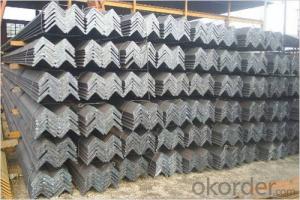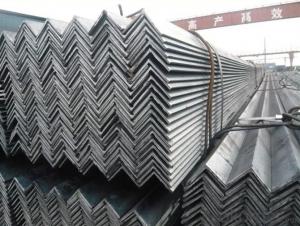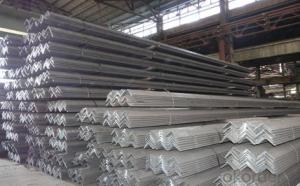Equal Steel Angle Steel Galvanized SS400 Best Angle Steel
- Loading Port:
- Tianjin
- Payment Terms:
- TT or LC
- Min Order Qty:
- 28 m.t.
- Supply Capability:
- 35000 m.t./month
OKorder Service Pledge
OKorder Financial Service
You Might Also Like
Product Description of Equal Steel Angle Steel Galvanized SS400 Best Angle Steel
1.Manufacturer
2. High quality, sincere service, fair price
3. Excellent Performance
Different Sizes of Equal Steel Angle Steel Galvanized SS400 Best Angle Steel
| StandardSectional Dimension mm | Weight kg/m | StandardSectional Dimension mm | Weight kg/m |
| 25*25*3 | 1.12 | 90*90*6 | 8.28 |
| 30*30*3 | 1.36 | 90*90*7 | 9.59 |
| 40*40*3 | 1.83 | 90*90*10 | 13.3 |
| 40*40*5 | 2.95 | 100*100*7 | 10.7 |
| 45*45*4 | 2.74 | 100*100*10 | 14.9 |
| 45*45*5 | 3.38 | 100*100*13 | 19.1 |
| 50*50*4 | 3.06 | 120*120*8 | 14.7 |
| 50*50*6 | 4.43 | 130*130*9 | 17.9 |
| 60*60*4 | 3.68 | 130*130*12 | 23.4 |
| 60*60*5 | 4.55 | 130*130*15 | 28.8 |
| 60*60*6 | 5.37 | 150*150*12 | 27.3 |
| 65*65*6 | 5.91 | 150*150*15 | 33.6 |
| 65*65*8 | 7.66 | 150*150*19 | 41.9 |
| 70*70*6 | 6.38 | 175*175*12 | 31.8 |
| 75*75*6 | 6.85 | 175*175*15 | 39.4 |
| 75*75*6 | 9.96 | 200*200*15 | 45.3 |
| 80*80*6 | 7.32 | 200*200*20 | 59.7 |
| 80*80*7 | 8.48 | 200*200*25 | 73.6 |
Product Specification of Equal Steel Angle Steel Galvanized SS400 Best Angle Steel
| Product | Equal Steel Angle Steel Galvanized SS400 Best Angle Steel |
| Product classification | Equal Angle Steel & Unequal Angle Steel |
| Production Technics | Hot rolled,cold-bend |
| Productivity | 300,000 Mt/Year |
| Main Material | SS400,Q235A,Q235B,Q345,Q345B,ASTM A36,S235JR,ST37,Stainless steel series,etc |
| Surface treatment | hot dip galvanised or cold dip galvanised |
| Specification | (20*20*2mm)-(200*200*25mm) |
| Theoretical weight per meter | =0.00785*(width+width-thickness)*thickness |
| Application | widely used in Power tower, communication tower, railway, highway, street lamp pole, marine parts, construction steel structure component, handling machinery ,Container frame , warehouse ,reaction tower,the substation ancillary facilities, light industry etc. |
| Length | 6m-12m as you require |
Applications of Equal Steel Angle Steel Galvanized SS400 Best Angle Steel
1. Pipe and Tubes for petrochemical industry
2. Pharmaceutical industry
3. Food industry
4. Aviation and aerospace industry
5. Architectural decoration industry
Advantages of Equal Steel Angle Steel Galvanized SS400 Best Angle Steel
We have both advanced production line, and advanced quality detecting, such as HLGER read-directlys
pectrum instrument, infrared CS analysis instrument, which can do ultrasonic test, crystal corrosion test and
metallographic test.

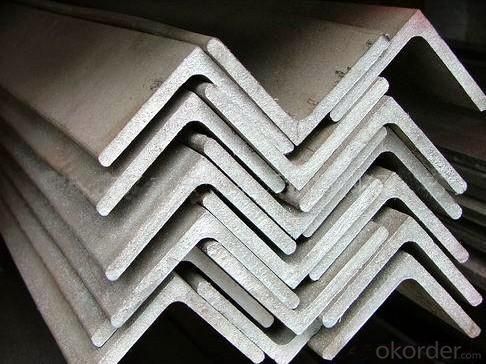
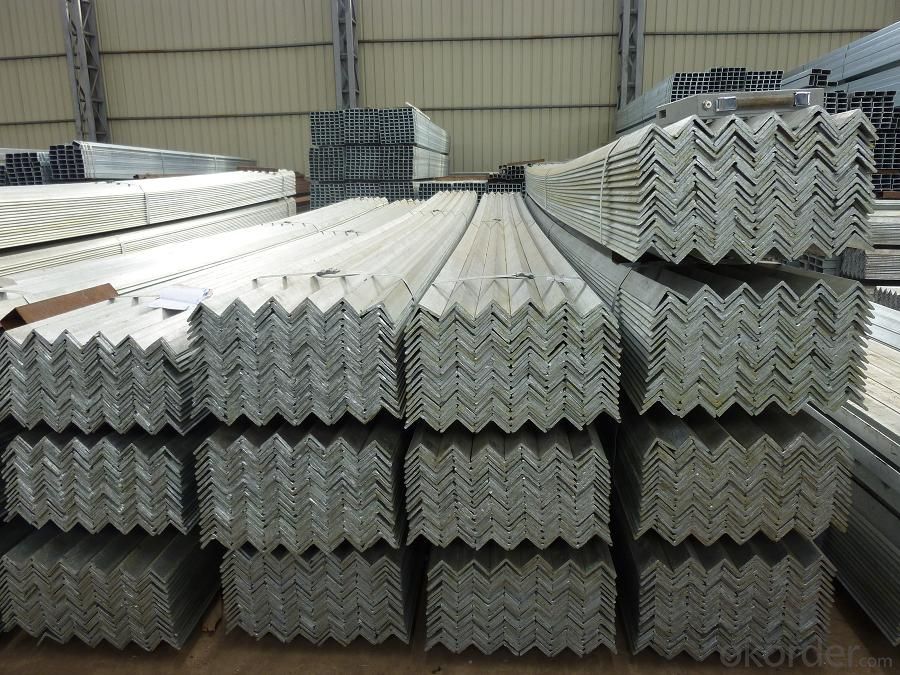
- Q:How do steel angles compare to other structural materials, such as wood or concrete?
- Steel angles have several advantages over other structural materials such as wood or concrete. Firstly, steel angles have a higher strength-to-weight ratio compared to wood or concrete. This means that steel angles can carry heavier loads while being lighter in weight. This advantage is particularly important in construction projects where weight restrictions need to be considered. Secondly, steel angles have excellent durability and resilience. Unlike wood, steel angles are not susceptible to rot, decay, or insect damage. They are also highly resistant to fire, which makes them a safer choice for structural applications. Concrete, on the other hand, is prone to cracking and deteriorating over time, whereas steel angles provide long-lasting structural integrity. Additionally, steel angles offer greater versatility in design and construction. They can be easily shaped and fabricated to fit specific project requirements, allowing for more efficient use of materials. Steel angles are also highly flexible, which makes them suitable for various applications, including beams, columns, trusses, and frames. Moreover, steel angles have excellent recyclability. They can be easily melted down and reused, reducing the environmental impact and promoting sustainability. In contrast, wood and concrete are not as easily recyclable, often resulting in waste during demolition or renovation projects. Lastly, steel angles offer cost-effectiveness in the long run. While the initial cost of steel may be higher than wood or concrete, the durability and low maintenance requirements of steel angles make them a more economical choice over time. With minimal repairs and a longer lifespan, steel angles can save on maintenance and replacement costs in the future. In conclusion, steel angles have numerous advantages over other structural materials like wood or concrete. Their higher strength-to-weight ratio, durability, versatility, recyclability, and cost-effectiveness make them an excellent choice for a wide range of construction projects.
- Q:Can steel angles be used in outdoor or exposed environments?
- Yes, steel angles can be used in outdoor or exposed environments. Steel angles are often made of galvanized steel, which is coated with a protective layer of zinc to prevent rusting. This makes them highly resistant to corrosion and suitable for outdoor applications. Additionally, steel angles are known for their strength and durability, making them a reliable choice for various outdoor structures, such as fences, railings, and supports. However, it is important to note that regular maintenance and inspection may be required to ensure the ongoing integrity and performance of steel angles in outdoor or exposed environments.
- Q:How do you prevent steel angles from sagging?
- Steel angles can be prevented from sagging by providing adequate support and reinforcement. This can be achieved by using additional structural steel elements such as beams or columns to provide continuous support along the length of the angle. Additionally, appropriate fastening techniques, such as welding or bolting, should be used to ensure a secure connection between the angle and the supporting structure. Regular inspection and maintenance are also essential to detect any signs of sagging and take necessary corrective measures in a timely manner.
- Q:Can steel angles be used for stairs?
- Yes, steel angles can be used for stairs. Steel angles are commonly used as stringers, which are the structural supports for stairs. They provide strength and stability to the staircase and can be a durable and reliable choice for stair construction.
- Q:How do steel angles compare to other materials like aluminum or wood?
- Steel angles are typically stronger and more durable than materials like aluminum or wood. They have a higher load-bearing capacity and can withstand greater amounts of stress and pressure. Additionally, steel angles are resistant to warping, rotting, and termite infestation, which are common issues with wood. However, steel angles are generally heavier and more expensive compared to aluminum. The choice between steel angles and other materials depends on the specific requirements of the project, such as strength, cost, and environmental factors.
- Q:How do you determine the shear capacity of a steel angle?
- The shear capacity of a steel angle can be determined by calculating the shear stress at the critical section, which is typically located at the junction between the web and the flange. This can be done by dividing the applied shear force by the effective shear area, taking into account the material properties and geometric dimensions of the angle. Additionally, design codes and standards provide tables and formulas that can be used to determine the shear capacity of steel angles based on their dimensions and loading conditions.
- Q:Are steel angles resistant to wind loads?
- Yes, steel angles are generally resistant to wind loads due to their high strength and structural integrity.
- Q:How do steel angles contribute to the overall aesthetics of a structure?
- Steel angles can contribute to the overall aesthetics of a structure in multiple ways. Firstly, steel angles can be used as decorative elements to create interesting and visually appealing designs. They can be incorporated into the architectural design to add unique and distinctive features to the structure. For example, steel angles can be used to create patterns, shapes, or even sculptures that enhance the overall aesthetic appeal of the building. Additionally, steel angles can be used to create a sense of balance and symmetry in the structure. By strategically placing steel angles at specific locations, architects can create a visually pleasing and harmonious design. The use of steel angles can help to break up large, monotonous surfaces and add depth and dimension to the structure, making it more visually interesting. Furthermore, steel angles can contribute to the aesthetic appeal of a structure by providing a sleek and modern appearance. The clean lines and sharp edges of steel angles can give a contemporary and industrial look to the building, which is often desired in modern architecture. The use of steel angles can also convey a sense of strength and stability, which can be visually appealing and reassuring to observers. Lastly, steel angles can be utilized to enhance the overall structural integrity of the building. While aesthetics are important, it is also crucial to ensure the safety and stability of the structure. Steel angles can be strategically placed to provide additional support and reinforcement, ensuring that the building is not only visually appealing but also structurally sound. In conclusion, steel angles can contribute to the overall aesthetics of a structure by adding decorative elements, creating balance and symmetry, providing a sleek and modern appearance, and enhancing the structural integrity. By incorporating steel angles into the design, architects can create visually stunning buildings that are both aesthetically pleasing and structurally sound.
- Q:Are steel angles suitable for balcony construction?
- Yes, steel angles are suitable for balcony construction. They are commonly used in balcony structures due to their strength, durability, and versatility. Steel angles provide excellent support and stability for balconies, ensuring their structural integrity. Additionally, steel angles can be easily customized and incorporated into various designs, making them a popular choice for balcony construction.
- Q:What is the maximum span for a steel angle?
- The maximum span for a steel angle depends on various factors, such as the size and thickness of the angle, the load it will be subjected to, and the type of support it has. Therefore, it is difficult to provide a specific answer without more information.
1. Manufacturer Overview |
|
|---|---|
| Location | |
| Year Established | |
| Annual Output Value | |
| Main Markets | |
| Company Certifications | |
2. Manufacturer Certificates |
|
|---|---|
| a) Certification Name | |
| Range | |
| Reference | |
| Validity Period | |
3. Manufacturer Capability |
|
|---|---|
| a)Trade Capacity | |
| Nearest Port | |
| Export Percentage | |
| No.of Employees in Trade Department | |
| Language Spoken: | |
| b)Factory Information | |
| Factory Size: | |
| No. of Production Lines | |
| Contract Manufacturing | |
| Product Price Range | |
Send your message to us
Equal Steel Angle Steel Galvanized SS400 Best Angle Steel
- Loading Port:
- Tianjin
- Payment Terms:
- TT or LC
- Min Order Qty:
- 28 m.t.
- Supply Capability:
- 35000 m.t./month
OKorder Service Pledge
OKorder Financial Service
Similar products
New products
Hot products
Related keywords
